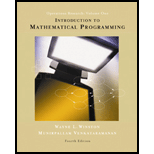
Concept explainers
Explanation of Solution
Using preemptive goal programming to determine a purchasing strategy:
- In the given problem, the Fruit Company has a budget constraint of $28000 to spend on 5000 excellent chips, 3000 good chips, and 1000 mediocre chips.
- If Fruit does not obtain enough chips of a given quality, the company may special –order additional chips at $10 per excellent chips, $6 per good chips and $4 per mediocre chip. But a penalty of $1 for each dollar by which the amount paid to supplier 1-3 exceeds the annual budget.
- Here, the user has to obtain the constraint equations and solve the linear equation to finding the penalty cost that will help the Fruit Company to minimize the penalty and meet its requirement of purchasing the chips annually.
Below given table gives the summary of the problem.
| Characteristics of a Lot of 100 chips | Price per 100 chips | Cost of 1 chip | |||
| Excellent | Good | Mediocre | |||
| Supplier 1 | 60 | 20 | 20 | $400 | $4.00 |
| Supplier 2 | 50 | 35 | 15 | $300 | $3.00 |
| Supplier 3 | 40 | 20 | 40 | $250 | $2.50 |
| Total | 5000 | 3000 | 1000 | ||
| Penalty cost | $10 per chip | 46 per chip | $4 per chip | $1 for every dollar over budget |
Consider the below given variables,
Lets,
To obtain 5000 excellent chips from all three suppliers, the below given equation can be used.
To obtain 3000 good chips from all three suppliers, the below given equation can be used.
To obtain 1000 mediocre chips from all three suppliers, the below given equation can be used.
As the Fruit Company operates on a budget, there exist a fourth constraint. This constraint will keep the Fruit Company as receiver as the suppliers may not demand the Fruit Company to ship chips to them.
Owing to the budget of
The above mentioned 4 constraints are flexible. That is the solution that minimizes the cost can either below or above the goal while it still can be used. The deviation variables
The above deviation variables are made use to be obtain the below constraints
Objective function:
The objective of the problem is to minimize the penalty cost particularly for additional chips that cost $10 for excellent, $6 for good and $4 for mediocre
Want to see the full answer?
Check out a sample textbook solution
Chapter 4 Solutions
Introduction to mathematical programming
 Operations Research : Applications and AlgorithmsComputer ScienceISBN:9780534380588Author:Wayne L. WinstonPublisher:Brooks Cole
Operations Research : Applications and AlgorithmsComputer ScienceISBN:9780534380588Author:Wayne L. WinstonPublisher:Brooks Cole
